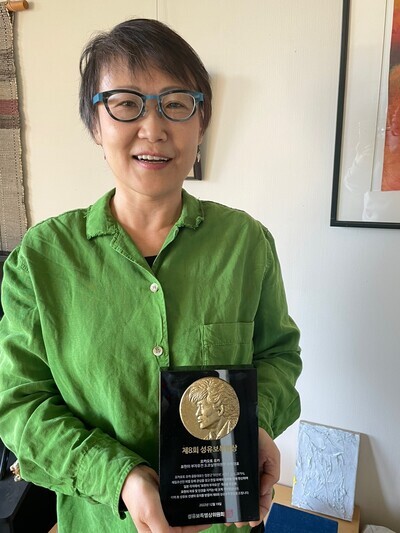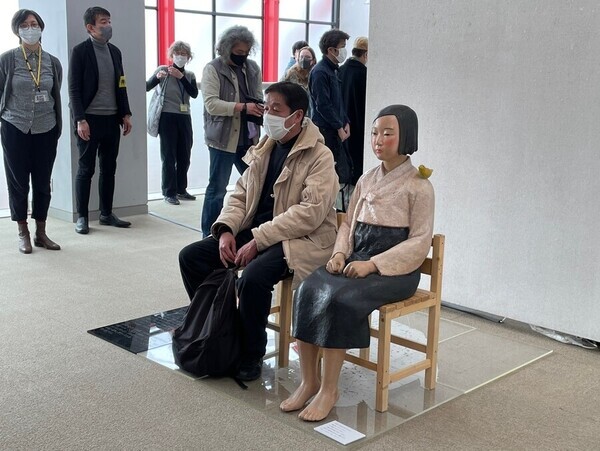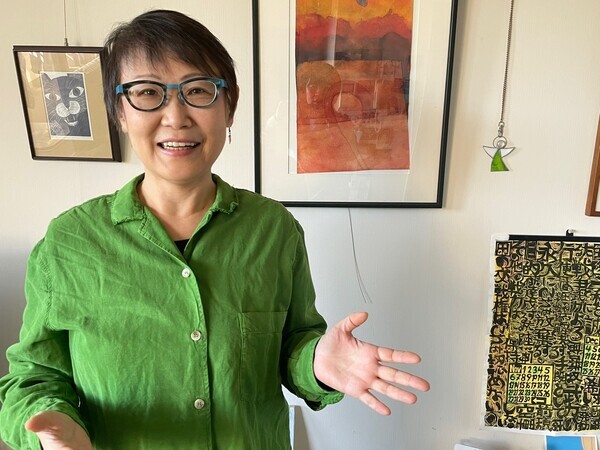hankyoreh
Links to other country sites 다른 나라 사이트 링크
[Interview] Right wing’s threats won’t stop fight for free expression, says Japanese organizer

“I was really astonished at how people in Korea recognized the significance of the ‘Non-Freedom of Expression’ exhibitions in Japan. It’s been a delight and a source of encouragement to me and all the other members who have been working so hard to stage the exhibitions.”
Speaking to the Hankyoreh at her home in Tokyo on Dec. 28, Yuka Okamoto, the 59-year-old co-representative of the Tokyo organizing committee for the “Non-Freedom of Expression” exhibitions, shared her thoughts on being presented with the 8th Seong Yu-bo Special Award, which honors the spirit of the late Seong Yu-bo (1943–2014), a journalist who served as the Hankyoreh’s inaugural chief editor.
Explaining the reason for Okamoto’s selection, the award’s selection committee pointed to how she had “contributed greatly to promoting freedom of exhibition and human rights by organizing the staging of ‘Non-Freedom of Expression’ exhibitions in various regions of Japan” and “long dedicated her energies to peace and reconciliation between South Korea and Japan, including matters such as the Japanese military ‘comfort women’ issue and anti-Zainichi Korean discrimination.”
The first foreign national to win the award, Okamoto was presented with the honor at a Dec. 19 ceremony at the Citizens’ Coalition for Democratic Media (CCDM) education center in Seoul.
Organizing Statue of Peace exhibitions in four cities as Tokyo organizing committee member, first foreign national honored with Seong Yu-bo Special AwardOkamoto has been one of the key figures organizing the “Non-Freedom of Expression” exhibitions, despite sabotage efforts and threats by members of Japan’s right wing. The exhibitions bring together work that has been taken down or subjected to restrictions by various institutions because it foregrounds topics that are sources of discomfort for Japanese society — including Statues of Peace symbolizing victims of wartime military sexual slavery, the imperial system, and the Fukushima nuclear disaster.
The aim of the exhibitions is to underscore the importance of freedom of expression by bringing together work that symbolizes “non-freedom of expression” in Japan.
Okamoto first became involved in the battle in 2012. At the time, the South Korean photographer Ahn Se-hong was scheduled to hold an exhibition focusing on victims of Japanese military sexual slavery at a Tokyo exhibition venue operated by the global camera company Nikon.
After right-wingers began adopting intimidation tactics, Nikon unilaterally canceled the exhibition. A court ultimately granted an injunction that allowed the Tokyo event to go ahead, but Nikon refused to publicize it and applied restrictions that included bans on press coverage and exhibition book sales.
Ahn filed suit for damages, and an association was formed in Japan to support his efforts. One of the members was Okamoto, who was then working as a freelance editor planning and producing exhibitions, films, books and magazines.
“Two months after the Nikon episode, a small ‘girl of peace’ statue that was being shown at the Tokyo Metropolitan Art Museum was taken down after four days. There was almost no mention of it in the media,” she recalled. Sensing that freedom of expression was being eroded, she and other colleagues who had been supporting Ahn at his trial decided to hold an exhibition to raise awareness of the troubling situation.
The first “Non-Freedom of Expression” exhibition finally took place in Tokyo in 2015. It drew attention for featuring a full-scale Statue of Peace seated in a chair — the first time one of the statues had been shown in Japan.

The exhibition was made possible with the help of the statue’s creators, husband-and-wife sculptors Kim Eun-sung and Kim Seo-kyung. As the organizers were fretting over the prohibitive costs of transporting the work from Seoul to Tokyo, the artists proposed bringing it over themselves.
“I was really surprised when they said they would be exhibiting the statue in Tokyo. But I was also really moved, because it wasn’t easy for them to transport it themselves,” Okamoto said.
The exhibition was a roaring success. The statue was exhibited without any disruptions, as the artists had intended. Japanese viewers sat down next to the statue to view and feel it; some of them suddenly burst into tears. Around 2,700 visitors came during the two-week period.
But as the interest intensified, so did the hardships. Perhaps the biggest example was the situation with the 2019 edition of the Aichi Triennale, Japan’s largest international art festival, which takes place in the city of Nagoya in Aichi Prefecture.
An invitation was extended to participate in the event, which kicked off on Aug. 1 of that year. But amid pressure not only from right-wingers but even from the mayor of Nagoya and Japanese chief Cabinet secretary, the exhibition was shut down after four days.
The situation became a source of great controversy in Japan that summer. Japanese news outlets scathingly criticized the government’s actions.
The exhibition finally reopened with just six days left in the event. As a result, it was only open to viewers for around 10 of the triennial’s 75 days. Another Tokyo exhibition in June 2021 ended up indefinitely postponed after persistent sabotage tactics by the right.
The process also birthed some big accomplishments. The Osaka organizing committee, which had been going through similar procedures of right-wing sabotage tactics leading to an exhibition’s cancellation, finally received an important decision in a legal case last year. The Osaka District Court sided with the exhibition’s Kansai organizing committee, declaring that the ability to restrict freedom of expression or assembly should only apply in cases where a “clear crisis” is foreseeable.
“The venue in which the Osaka organizing committee was seeking to hold the exhibition was a public facility. What we learned from observing the Osaka situation was that for public facilities to belong to the public, the public needs to uphold them.”
“Freedom of expression should not be infringed upon by threats from the right wing,” Okamoto said. “It is difficult, but it feels like climbing one step at a time,” she said happily.

Encouraged by the Osaka case, the Statue of Peace was exhibited at a public gallery in Kunitachi, Tokyo for the first time in seven years in April last year.
This was followed by the “Non-Freedom of Expression” exhibition being held in four places including Kyoto, Nagoya and Kobe.
“There were many from the right wing present, but we were able to finish safely because we prepared safety measures and thanks to the support of citizens,” Okamoto said. In Tokyo alone, 240 volunteers and over 60 lawyers came out to support the exhibit and its organizers.
Amid Okamoto’s valiant fight against forces attempting to limit freedom of expression, in 2008 she was diagnosed with cancer, and had a close brush with death. She continues to undergo medical testing to this day.
"It's a miracle that I survived then. After I got sick, I was able to decide what I wanted to do faster than before. I don't know when I'll die, but I realized that it’s better to live like this,” Okamoto said.
Okamoto thinks she will be busy this year too. “I can't reveal the name of the place, but there is a new place where I would like to hold a Non-Freedom of Expression exhibition,” she says.
"In addition, I am also serving as the executive director of programming meetings for Fight for Justice, an academic site on comfort women which marks its 10th founding anniversary this year. I am thinking about how I can further strengthen this work,” Okamoto says.
“This is something I want to do and I'm happy that I'm doing something I can do,” she said, smiling brightly.
By Kim So-youn, Tokyo correspondent
Please direct questions or comments to [english@hani.co.kr]

Editorial・opinion
![[Editorial] Penalties for airing allegations against Korea’s first lady endanger free press [Editorial] Penalties for airing allegations against Korea’s first lady endanger free press](https://flexible.img.hani.co.kr/flexible/normal/500/300/imgdb/original/2024/0502/1817146398095106.jpg) [Editorial] Penalties for airing allegations against Korea’s first lady endanger free press
[Editorial] Penalties for airing allegations against Korea’s first lady endanger free press![[Editorial] Yoon must halt procurement of SM-3 interceptor missiles [Editorial] Yoon must halt procurement of SM-3 interceptor missiles](https://flexible.img.hani.co.kr/flexible/normal/500/300/imgdb/child/2024/0501/17145495551605_1717145495195344.jpg) [Editorial] Yoon must halt procurement of SM-3 interceptor missiles
[Editorial] Yoon must halt procurement of SM-3 interceptor missiles- [Guest essay] Maybe Korea’s rapid population decline is an opportunity, not a crisis
- [Column] Can Yoon steer diplomacy with Russia, China back on track?
- [Column] Season 2 of special prosecutor probe may be coming to Korea soon
- [Column] Park Geun-hye déjà vu in Yoon Suk-yeol
- [Editorial] New weight of N. Korea’s nuclear threats makes dialogue all the more urgent
- [Guest essay] The real reason Korea’s new right wants to dub Rhee a founding father
- [Column] ‘Choson’: Is it time we start referring to N. Korea in its own terms?
- [Editorial] Japan’s rewriting of history with Korea has gone too far
Most viewed articles
- 160% of young Koreans see no need to have kids after marriage
- 2Months and months of overdue wages are pushing migrant workers in Korea into debt
- 3[Editorial] Penalties for airing allegations against Korea’s first lady endanger free press
- 4[Guest essay] Maybe Korea’s rapid population decline is an opportunity, not a crisis
- 51 in 3 S. Korean security experts support nuclear armament, CSIS finds
- 6[Reporter’s notebook] In Min’s world, she’s the artist — and NewJeans is her art
- 7Bills for Itaewon crush inquiry, special counsel probe into Marine’s death pass National Assembly
- 8S. Korea discusses participation in defense development with AUKUS alliance
- 9Japan’s standards for use of preemptive counterstrike against N. Korea remain unclear
- 10Trump asks why US would defend Korea, hints at hiking Seoul’s defense cost burden